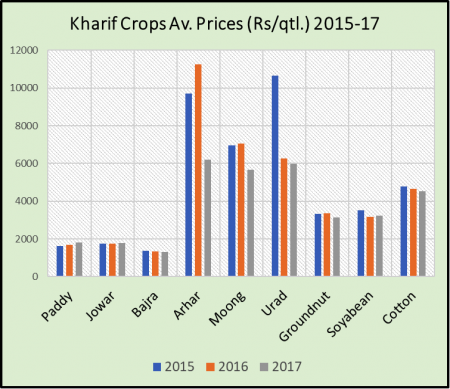Agri Distress Deepens as Crop Prices Crash

It is perhaps a symbol of our times, and this govt.’s alienation from the people, that it is totally unconcerned about crashing farm produce prices even though the Prime Minister and his colleagues go on harping on their commitment to double farmers’ incomes.
Here is what has happened to rabi (winter) crops. Wheat prices have inched up by 4% since 2016. Bengal gram and masur dal prices offered to farmers in wholesale markets (mandis or APMCs) are down 37% and 24% respectively. Safflower prices are up 8% while mustard is down 8%. Barley (jau) prices are down 5%. Average annual inflation rate, that is yearly price rise, has been 4-5%, in these years and clearly, the tiny increase in prices that the farmers got would have been wiped out by the inflation.

In fact, some of the inputs that the farmers use – like diesel to run their generators for pumps and machines – have risen far beyond the average inflation. For instance, diesel prices increased 23% in the four years of Modi Sarkar. So the farmers are losing out much more.
A similar story was seen in the previous kharif (monsoon) crop. Although paddy prices increased by about 11% in 2017 and jowar by 2%, bajra fell by 5%, arhar by 36%, moong by 19%, urad by 44%, groundnut by 5%, soyabean by 8% and cotton by 5%.

These are prices actually received by the farmers not the Minimum Support Prices (MSPs) announced by the govt. which are often abandoned (except in wheat and paddy) because: a) farmers want quick returns and can’t wait for the rigmarole involved in approaching govt. agents, and b) govt. acquisition is patchy at best and often not done at all as in pulses.
The tragedy of the farmers is that the govt. has no vision or policy which is coming anywhere near addressing this problem. Making promises in bombastic speeches comes for free and that is what the govt., right from the Prime Minister downwards, is doing. All the time, prices are in free fall, bringing ruin to crores of farmers.
Not surprisingly, it is not as if consumers are benefitting from these falling farm produce prices. A long and entrenched chain of middlemen continues to mark up prices of commodities as they move from farms to dining tables. So, retail prices have actually risen by an average of 21% in Modi’s rule.
In sum, the agricultural policy of the govt. has seen an average growth of less than 3% in the past four years, mounting debt for farmers, mass abandoning of cultivation and migration to non-farm menial jobs, stagnant agricultural wages. Is that what ‘ ache din’ was all about?
Get the latest reports & analysis with people's perspective on Protests, movements & deep analytical videos, discussions of the current affairs in your Telegram app. Subscribe to NewsClick's Telegram channel & get Real-Time updates on stories, as they get published on our website.
























